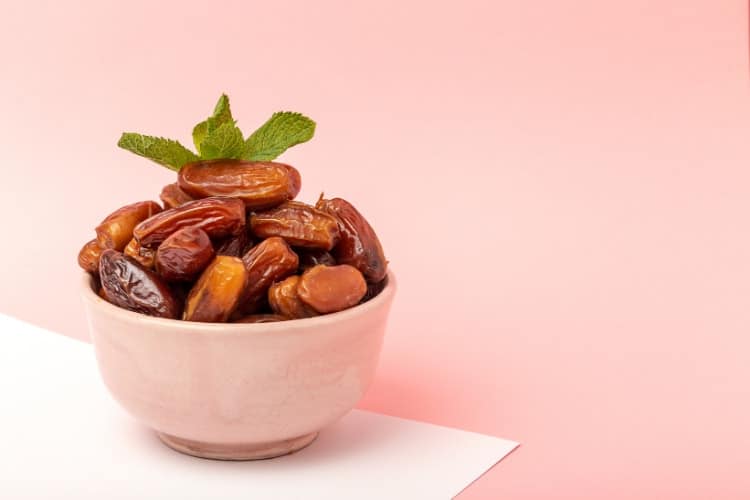
Ever considered eating dates for iron deficiency? If you haven’t, then you might be pleasantly surprised to hear that dates can actually be used as a natural remedy for low iron or anemia.
In fact, several studies have shown that the date fruit – which is a natural source of iron – is quite beneficial for those struggling with iron deficiency anemia.
So, if you’d like to learn more then keep reading because this article is going to cover:
- what science has to say about consuming dates for low iron.
- which types of dates to eat.
- how many dates to eat for low iron.
CAN DATES INCREASE IRON?
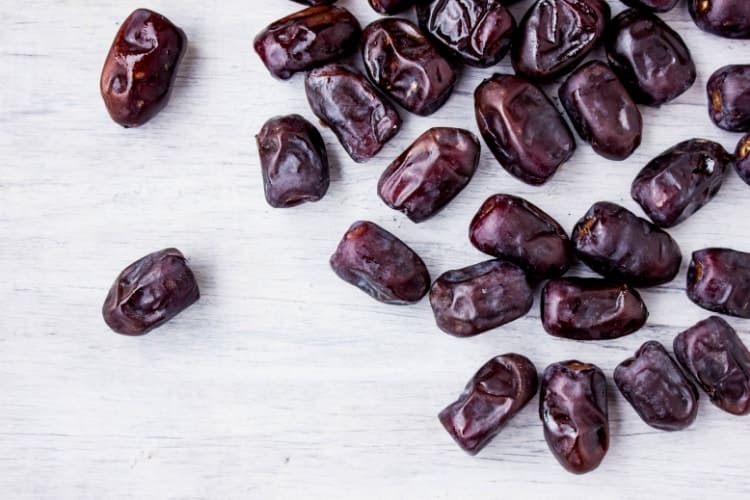
Multiple studies show that dates are an effective way of naturally increasing iron levels in both children and adults. Researchers attribute date’s iron-boosting properties to its iron content, as well as to the fact that it contains multiple nutrients that enhance iron absorption and hemoglobin production.
To give you a better idea of how dates can improve both iron and hemoglobin levels, here’s a quick overview of some of those studies.
1. Dates Improve Iron Deficiency Anemia in Girls Aged Aged 8 to 10
A study published in the journal Pediatric Health, Medicine and Therapeutics showed that adding dates to the diets of young, iron-deficient girls, improves iron and hemoglobin levels (source).
Here’s a summary of what the study entailed, as well as the results:
- At the start of this study, the mean hematocrit (Hct) was 34.24 g/dL, the mean ferritin (standard measure for iron) was 47.07 μg/dL and the mean hemoglobin (Hgb) was 11.19 g/dL.
- The participants consumed Mazafati dates for 2 months. No other dietary changes were made.
- After 2 months the girls showed improvements in all categories: mean hematocrit (Hct) was 37.17 g/dL, mean ferritin was 53.98 μg/dL and mean hemoglobin (Hgb) was 12.05 g/dL.
- Dates contain vitamin A, which helps with the synthesis of hemoglobin. Interestingly, some studies and experts state that vitamin A deficiency tends to go along with anemia. And low vitamin A can decrease iron absorption, further contributing to the development of anemia. Furthermore, another report indicates that taking vitamin A and iron together seems to be more effective at preventing iron deficiency, versus taking them individually (1, 2, 3).
- Vitamin C is also found in dates and it’s known to enhance iron absorption.
From a scientific perspective, the results of this study were considered statistically significant.
2. Dates Might Work As A Substitute for Iron Supplements
In an attempt to evaluate just how helpful dates can be for iron deficiency, researchers conducted a study comparing date consumption with iron pills and a date drink. They concluded that dates can be a suitable substitute for iron pills (source).
In that study the participants were divided into four groups. Each group was assigned the following foods or supplements for 30 days:
| Group A | Sayer dates |
| Group B | a drink made of dates and water |
| Group C | iron supplements in the form of ferrous sulfate. |
| Group D | iron supplements in the form of ferrous gluconate. |
Here’s a summary of what the study entailed and the findings:
- After 30 days, each group showed an increase in hemoglobin levels.
- Interestingly, the group that consumed dates had strong results. Strong enough for the researchers to conclude that dates could be used in place of iron supplements.
- The groups that consumed dates, as well as the group that consumed the date drink, had fewer bowel issues compared to the group that took iron pills. Since high doses of iron pills tend to cause constipation, this outcome was seen as yet another reason why dates could be a good alternative to iron pills.
- Dates are high in fiber, which is another reason why dates could cause less constipation than iron pills.
3. Dates Improve Hemoglobin Levels in Pregnant Women
A 2017 study published in the Journal of Food and Nutrition Research found that dates are beneficial for pregnant, anemic women (source).
In the study, pregnant women struggling with anemia were split into four groups and assigned to consume the following for 90 days:
| Group A | lactose capsules |
| Group B | blackstrap molasses |
| Group C | a paste made of dried dates, dried apricots, blackstrap molasses and rape seeds |
| Group D | iron supplement (ferrous sulphate) and lactose |
Overall, each group – except Group A – consumed 13.5 mg of iron, which is 50% of the RDA for iron during pregnancy.
This was the outcome of the study:
- The results showed that Group C (dried dates, dried apricots, blackstrap molasses and rape seeds) had the most significant improvements in all measurements (ferritin, hematocrit and hemoglobin). Interestingly, Group B (blackstrap molasses) had the strongest increase in serum ferritin specifically.
- In conclusion, the researchers pointed out that natural sources of iron, such as dates, seem to be more bioavailable (i.e. more easily absorbed) than iron pills.
HOW MANY DATES SHOULD YOU EAT PER DAY FOR IRON DEFICIENCY?
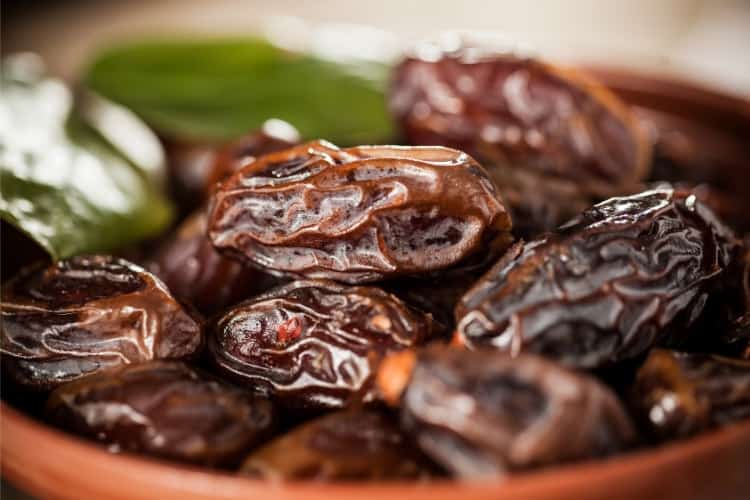
Some research shows that consuming 100 grams of dates per day is ideal for improving iron deficiency. This is equivalent to approximately 4 or more dates, depending on the variety.
But how much iron can you expect to get in 100 grams of dates? Well, it can vary quite a bit. For example:
- Tunisian dates are on the high end of the spectrum with 7.2 mg of iron for every 100g serving (40% of the RDA for an adult woman).
- Ajwa dates are on the lower end of the spectrum with 0.85 mg of iron for every 100g serving (4.7% of the RDA for an adult woman).
So, based on the above information, you can expect to get approximately 5 – 39% of the RDA of iron from a 100 gram serving of dates.
This is actually quite good considering that you’ll be eating other meals or snacks throughout the day, all of which will contribute to your total iron intake for the day.
Now, if you’re not sure what the recommended intake for iron is, here’s a quick refresher (source):
- Girls and boys aged 9 – 13: 8 mg
- Non-pregnant women aged 19 – 50: 18 mg
- Pregnant women aged 19 – 50: 27 mg
- Women and men 51 and above: 8 mg
Lastly, here is a simple comparison table of some date varieties and their corresponding iron content (4, 5, 6)
| Date Type | Iron Content | Serving size |
|---|---|---|
| Medjool | 0.9 mg (5% of RDA) | 100 g |
| Deglet | 1.02 mg (5.7% of RDA) | 100 g |
| Ajwa | 0.85 mg (4.7% of RDA) | 100 g |
| Halawi | 0.7 mg (4% of RDA) | 85 g |
WHICH DATES ARE BEST FOR HEMOGLOBIN?
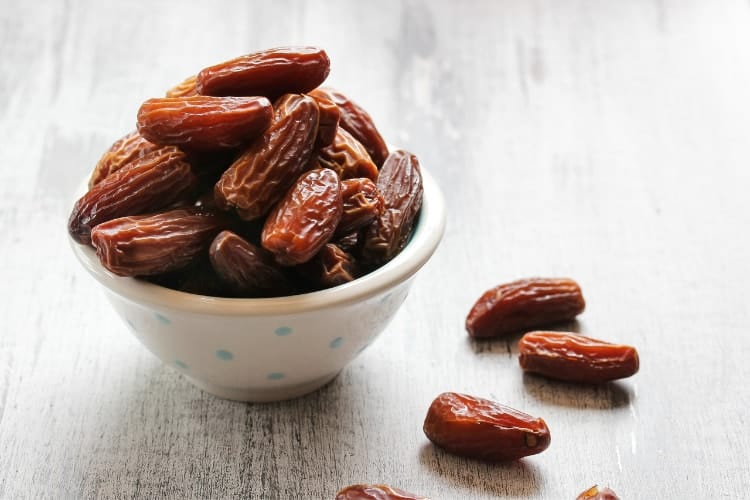
Even though the specific quantities of iron and other nutrients can vary from one type of date to another, all varieties of this fruit provide similar health benefits. Therefore, when it comes to increasing hemoglobin, simply go with the dates that are available in your area, be it medjool, deglet, halawi or some other type.
Also, be aware that there are hundreds of date varieties to choose from (source). However, here in the U.S. the three listed above are some of the easiest to find in many grocery and healthy food stores. However, if you visit a local farmer’s market, a local Middle Eastern grocery store or you shop online, you will likely find other types such as ajwa, barhi and more.
Now, here’s a general overview of what to expect from a few date varieties (in terms of taste and texture).
Medjool Dates
- Very soft, moist and plump, with a firm (but not hard) texture.
- Can be pricier compared to other types of dates.
Deglet Dates
- Smaller in size compared to medjool.
- Less moist when compared to medjool dates.
Halawi Dates
- Soft and thick flesh.
- Has more of a distinct caramel flavor that is different from both medjool and deglet varieties.
Ajwa Dates
- Soft yet chewy texture.
- Flavor has hints of caramel, honey and cinnamon.
ADDITIONAL TIPS AND FAQs ABOUT EATING DATES FOR IRON DEFICIENCY
There are tons of different ways in which you can consume dates for low iron. For example, you can add them to:
- smoothies.
- yogurt.
- oatmeal.
- your favorite trail mix blend.
- homemade granola bars or energy balls.
Now, here are some common questions that generally come up about date consumption.
What is the best time to eat dates?
Dates can be consumed at any time of day, be it during breakfast, as a morning or afternoon snack, or as a pre-workout snack (great energy booster). You can also eat them as an evening snack. However, if you’re particularly sensitive to sugar, then give yourself at least 1 to 2 hours between your bedtime and your date snack.
Is it good to eat dates on an empty stomach?
Whether or not you should have dates on an empty stomach – especially first thing in the morning – is a matter of personal preference. If you do an intense workout as soon as you wake up, for example, then dates can be an excellent pre-workout snack.
However, if you prefer to start your days slowly, you may find that dates are a lot to handle right out of bed. In this case, you may want to drink a glass of lemon water first, followed by fresh juice or a smoothie. Then you can have dates later in the morning as a mid-morning snack.
Another option is to simply add dates directly to your morning smoothie. Not only will this naturally sweeten your smoothie, but if you’re having a green smoothie, the vitamin C from the dates can help you better absorb the iron from the smoothie greens.
What does soaking dates in water do?
Dates tend to dry out over time, even when they’re stored properly. It doesn’t mean they’re bad. They just need to be revived. And soaking them in water is all you need to do to get them to be soft, plump and moist.
To soak your dates, simply:
- Boil some water.
- Place dates in a bowl or cup.
- Pour boiling water over them (enough to fully cover them).
- Let the dates soak for about 10 minutes.
- Drain out the water and voilà! You have delicious, moist dates that you can eat as is or throw into a smoothie (they’re much easier to blend after soaking!).
Who should not eat dates?
If you have diarrhea or loose stools, then you might want to avoid dates (or eat less of them). This is because dates contain a compound called sorbitol, which can have a laxative effect (source).
In addition, if you have gut-related issues like irritable bowel syndrome and/or you’re on a low FODMAP diet, dates may not be for you. The natural sugars in dates could irritate your gut.
What fruit is high in iron?
Dried fruit contains the highest amount of iron. This includes dried peaches, apricots, dates, prunes and apples. Although the drying process can sometimes destroy certain nutrients, it also enhances others, such as iron and fiber (source).
What drink is high in iron?
Prune juice, stinging nettle tea, red raspberry leaf tea, dandelion tea and yellow dock root tea are all examples of drinks that are high in iron. In addition, these drinks contain other nutrients that help the absorption of iron.
CONCLUSION
More than just a healthy, natural sweetener, dates are a nutrient-rich fruit that supplies iron, fiber, vitamin A, vitamin C, B vitamins, potassium, zinc, phosphorus, selenium and several dozens of amino acids (source).
So, if you’re struggling with low iron and/or you’re anemic, this is one fruit that you should seriously consider adding to your diet. So far the research looks really promising!
Also, if you’re concerned about the sugar content in dates, you should know that they have a somewhat low glycemic index. However, the specific GI value varies depending on the variety. For example, one study that looked at 5 dates varieties showed that they range from 44 to 53 on the glycemic index (source).
So, overall anyone with diabetes or other blood sugar issues can still consume dates, but in moderation.
Now that you’re armed with this information, I hope this article helps you understand how you can use dates to improve iron deficiency.
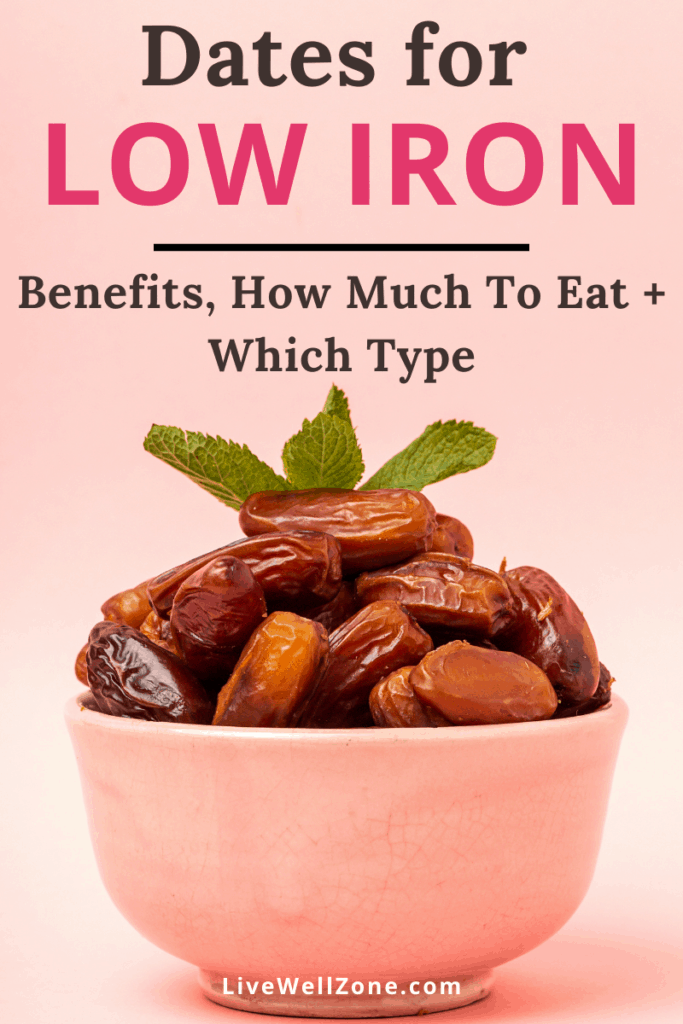
Related Posts:
Healthy Smoothies for Low Iron (For Energy, Weight Loss, Natural Glow)
Beet Smoothie for Low Iron: Benefits, Which Parts To Use (Root vs. Leaves) and Recipe
3 Ways to Use Ginger Root for Heavy Periods
A Complete Guide to Using Vitamin C for Heavy Menstrual Bleeding
3 Reasons To Use Blackstrap Molasses for Heavy Periods
10 Herbs for Heavy Menstrual Bleeding (That You Need To Know!)

